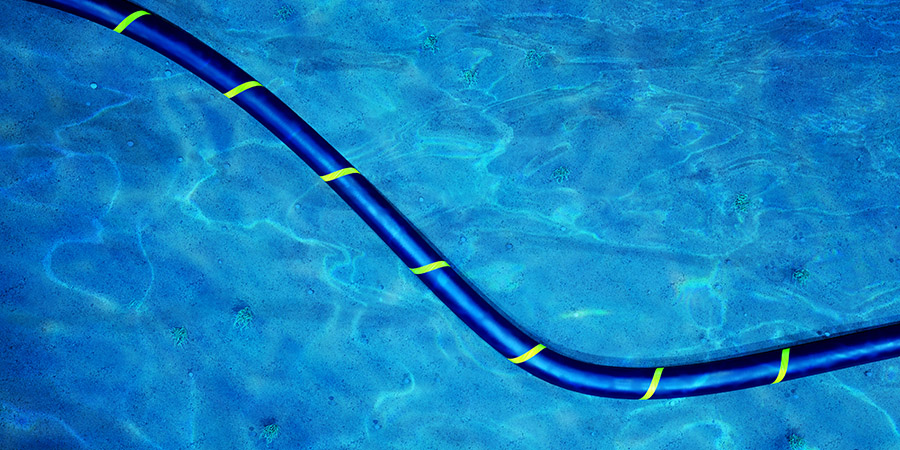Submarine cables are the backbone of global digital connectivity, transmitting over 99% of intercontinental data traffic. Nowhere is this infrastructure more vital than in Asia, a region that serves as a crucial hub for global internet traffic. However, climate change presents significant environmental risks to submarine cables, threatening connectivity and economic stability.
As of 2025, the Asia Pacific faces escalating climate change challenges, with projections indicating that, under a high-emission scenario, climate change could reduce the regional GDP by 16.9% by 2070, with countries like Vietnam potentially experiencing losses up to 30%. The region, home to 70% of the global population, accounted for nearly half of the world's emissions in 2021, primarily from China and South Asia. Despite China's commitment to reduce carbon emissions by 2030, a Centre for Research on Energy and Clean Air (CREA) survey indicated that 44% of experts believe China's CO₂ emissions have already peaked, or will peak, by 2025.
However, the South West Pacific has experienced sea-level rises at rates more than double the global average over the past 30 years, posing significant threats to low-lying islands. To combat these challenges, the United Nations estimates that nearly USD 145 billion is needed to establish disaster warning systems and other tools to mitigate climate-related risks in the region.
Global dependency on submarine cables cannot be overstated. These cables are critical not only for internet connectivity but also for economic activities such as banking transactions, stock market exchanges, and communication systems in both civilian and military contexts. Southeast Asia, for instance, relies heavily on undersea cables for telecommunication traffic, which is often disrupted by environmental factors.
Approximately 99% of international data passes through submarine cables, with Southeast Asia housing over 12 major undersea cables that are integral to the region’s connectivity. The demand for bandwidth continues to rise, with internet penetration in Southeast Asia exceeding 70%.
Latest Read: China Telecom Launches Asia Direct Cable Capacity Ahead of Schedule
Environmental Risks to Submarine Cables
Submarine cables are under constant threat from various environmental factors exacerbated by climate change. Rising sea levels, which can submerge key landing stations and coastal infrastructure, pose one of the most significant risks. According to the International Telecommunication Union (ITU), around half of the global population lives within 200 km of the ocean, putting critical telecommunications infrastructure at risk.
Additionally, Southeast Asia is located within the Pacific Ring of Fire, which is known for its seismic activity, where frequent tectonic shifts can trigger earthquakes and undersea landslides. These natural phenomena pose significant risks to submarine cables. For instance, in 2006, a 7.0-magnitude earthquake off Taiwan caused multiple cable failures, resulting in communication disruptions across Asia. The earthquake-induced landslides generated powerful sediment flows that severed over 20 cables in the Luzon Strait, causing prolonged internet outages in countries such as Malaysia, Singapore, and Thailand.
Indonesia and the Philippines are especially vulnerable due to their complex underwater topography, including deep ocean trenches and unstable slopes. For instance, the 2021 undersea cable disruption caused by Typhoon Odette in the Philippines resulted in a considerable loss of internet services for thousands of users across the region, highlighting the vulnerabilities of critical infrastructure to natural disasters.
Climate change is exacerbating the intensity of typhoons in the Asia Pacific, which, in turn, affects submarine cable stability. More powerful typhoons can lead to increased seabed disturbances, shifting underwater sediment and destabilizing cables. In 2009, Typhoon Morakot triggered massive sediment displacements in Taiwan’s Gaoping Submarine Canyon, damaging several cables.
Rising sea temperatures are also altering ocean currents, which affects cable routing and durability. Stronger and more erratic currents may increase cable exposure to environmental hazards such as coral growth, underwater erosion, and unexpected seabed shifts.
As sea levels rise due to global warming, coastal areas housing cable landing stations face increased risks of flooding and erosion. For example, Vietnam has experienced multiple cable failures in the past two years due to shipping activity and suspected degradation. In 2023, five major cables connecting the country to the global internet suffered simultaneous failures.
Related: Telecoms Role in Driving Progress Towards SDGs in India, Vietnam and Indonesia
Mitigation Strategies for Submarine Cable Resilience
One of the most effective ways to enhance cable resilience is by diversifying and strategically planning cable routes. Japan's submarine cables are highly concentrated in two key areas—Minami-Boso in Chiba Prefecture and Shima in Mie Prefecture—prompting the government to diversify routes to prevent widespread internet disruptions. Another notable example is Meta's ambitious Waterworth Project, announced in February 2025. Similarly, Google's expansion of its USD 1 billion undersea cable project seeks to connect Darwin and Singapore via Christmas Island, while the Asia Connect Cable, slated for 2027, further illustrates this approach by bypassing the geopolitically sensitive South China Sea in favor of the Java Sea.
Additionally, submarine cable landings should avoid high-risk geological zones, such as active seismic areas and submarine canyons, where landslides and sediment shifts are frequent. Improved geological mapping and predictive modeling can assist in identifying safer routes for new cable installations.
Older cables in Asia, particularly those laid in the early 2000s, were often buried at shallow depths of only one meter or less, making them highly vulnerable to ship anchors and natural sediment movements. Newer cables should be buried deeper into the seabed and reinforced with stronger armoring to withstand both human and environmental disruptions. Countries such as Japan have already implemented advanced burial techniques, with some cables buried more than two meters beneath the seabed in high-risk areas. These strategies should be adopted across Southeast Asia to improve cable resilience.
In light of rising sea levels and coastal erosion, cable landing stations must be designed to withstand the impacts of climate change. Singapore’s plans to double its number of landing sites within the next 10 years should incorporate elevation adjustments and protective barriers to prevent flooding risks. Additionally, modular and floating landing stations could provide adaptive solutions for areas prone to flooding.
Real-time monitoring of subsea cables using AI-powered predictive analytics can help detect potential threats before they escalate to catastrophic failures. Underwater sensors and autonomous monitoring systems could help track environmental changes, such as temperature fluctuations, seismic activity, and seabed movements.
The success of regional cable initiatives, such as the SEA-ME-WE consortium projects and the Asia-America Gateway cable, demonstrates the potential of collaborative efforts in maintaining secure and resilient digital infrastructure. Expanding these partnerships will be crucial in addressing the climate-related challenges facing the submarine cable industry.
At the same time, hyperscalers such as Microsoft, Amazon, Google, and Meta are transforming the submarine cable landscape. No longer just consumers of bandwidth, these tech giants have shifted toward owning and controlling cable infrastructure to meet surging data demands. Between 2019 and 2023, hyperscalers accounted for 23.5% of 102 newly activated cable systems. While this investment boosts connectivity in Southeast Asia, it also raises concerns about market consolidation, national security, and regulatory oversight.
United States (U.S.) national security agreements, for example, ensure data protections primarily for American citizens, leaving other nations potentially exposed to mass surveillance. To address these challenges, ASEAN is taking steps to strengthen cable resilience. The fourth ASEAN Digital Ministers’ Meeting in 2024 announced plans for a secure and diverse submarine cable network, though details remain limited.
Interesting Read: Malaysia’s Blueprint for AI Dominance in ASEAN
The Role of Telecom
As submarine cables are exposed to environmental risks, telecommunications companies, hyperscalers, and vendors are stepping up to protect their infrastructure. The growing awareness of climate risks has led many stakeholders in the Asia Pacific to focus on building more resilient cable systems.
Telecom operators like PLDT in the Philippines have taken proactive measures to mitigate the impact of environmental hazards. PLDT, which participates in the Apricot subsea cable network, has invested in building landing stations in less vulnerable areas such as Davao and Aurora, reducing the risk of potential damage due to typhoons or territorial conflicts. Such efforts aim to enhance the resilience of telecom infrastructure, ensuring uninterrupted service even in the face of natural disasters or geopolitical tensions.
Hyperscalers, such as Google and Amazon, are also playing a critical role in addressing climate change risks to submarine cables. Google’s focus on diversifying its subsea cable routes and choosing alternative paths, like those used by the Echo and Bifrost cables, is part of a broader strategy to mitigate the environmental and geopolitical risks of cable infrastructure.
As part of the SEA-ME-WE 6 cable project, HMN Technologies aims to develop cables that can better withstand harsh environmental conditions, such as extreme temperatures, strong currents, and potential underwater seismic activities. These advancements are critical for ensuring the longevity of submarine cables, especially in regions like Southeast Asia, where environmental conditions are particularly volatile.
Moreover, advancements in monitoring technologies are enabling real-time assessments of subsea cable health. By using sensors and underwater drones, telecom operators can detect potential damage to cables before it leads to service disruptions. This proactive approach allows for quicker repairs, minimizing the impact on connectivity.
In terms of resilience, Brian Lavallée, Senior Director of Market and Competitive Intelligence at Ciena, highlighted the role of the International Cable Protection Committee (ICPC) in promoting the protection and resilience of submarine cables. As a member of the ICPC, Ciena collaborates with industry stakeholders to enhance the durability and security of global submarine networks.
With no alternative to submarine cable coherent optical transmission, relentless technology innovation across our entire network industry is required if we’re to maintain pace with the unyielding and voracious demand growth of 31% worldwide—a doubling of capacity every 2.5 years.
Beyond the Seabed
The future of submarine cables in the face of climate change will require both adaptive infrastructure and innovative geopolitical strategies.
The ITU, in collaboration with the International Cable Protection Committee (ICPC), established the International Advisory Body for Submarine Cable Resilience in November, 2024, bringing together stakeholders to develop strategies to bolster the durability and security of these vital networks. These concerted efforts underscore the global commitment to safeguarding submarine cables against environmental hazards and ensuring interconnectivity.
As demand for high-speed internet and telecommunications continues to rise, identifying climate risks and fortifying submarine cable infrastructure will be vital to maintaining the stability of global communication networks.
Related:
APTelecom Leads in Converged Connectivity and Subsea Cable-Driven Digital Infrastructure Development
Sparkle Transforms its Submarine Cable Network and the Market
Anup Gupta on APTelecom’s Subsea Innovations and Tackling Digital Security






